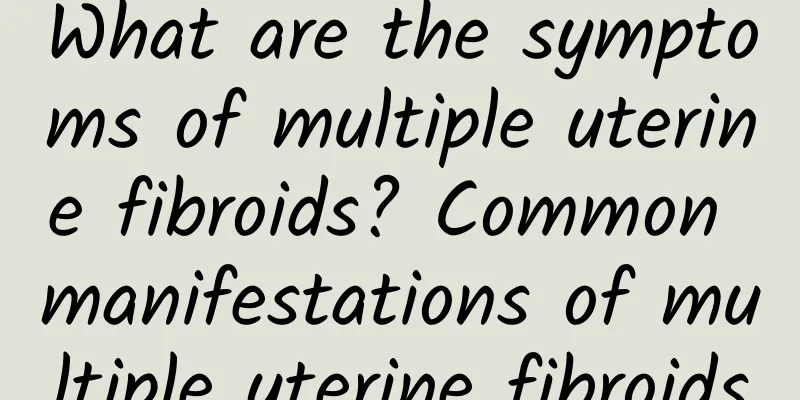What are the symptoms of multiple uterine fibroids? Common manifestations of multiple uterine fibroids

|
The symptoms of multiple uterine fibroids in the early stage are not obvious, and some women usually have no symptoms in the early stage, which is often very unfavorable to the development of the disease. Therefore, experts remind female friends that the key is to understand the symptoms of multiple uterine fibroids as soon as possible in order to better prevent and control the disease. The symptoms of multiple uterine fibroids are usually different for each person, mainly related to the size, location and growth rate of the fibroids. The common clinical symptoms of multiple uterine fibroids are mainly the following: 1. Menstrual changes: This is a very common symptom, which is usually prone to menorrhagia, prolonged menstruation, and even irregular vaginal bleeding. Submucosal fibroids usually cause menorrhagia, and as the fibroids grow larger, the menstruation becomes longer. Once the fibroids become necrotic, ulcerated, or infected, there will be persistent or irregular vaginal bleeding or purulent expansion fluid. Subserosal fibroids and intramural small fibroids often do not have obvious menstrual changes. 2. Abdominal mass: Patients with uterine fibroids are prone to symptoms of abdominal mass, which is easier to touch in the morning when the bladder is full. It is hard in texture and irregular in shape. 3. Bleeding: Submucosal fascia and myoma increase the area of uterine cavity and increase menstrual volume. 4. Abdominal pain, backache, lower abdominal swelling: Patients usually have no abdominal pain, but acute abdominal pain occurs when the pedicle of the subserosal fibroid is twisted. When the fibroid is red, the abdominal pain is severe, accompanied by fever. Lower abdominal swelling and back pain are common, and menstruation is aggravated. 5. Compression symptoms: Myoma compresses the bladder, causing frequent urination, urinary dysfunction, urinary retention, etc. Compression of the ureter can cause hydronephrosis, and compression of the rectum can cause difficulty in defecation. 6. Infertility: According to literature reports, it accounts for 25% to 40%. It may be that the fibroids compress the fallopian tubes and deform the uterine cavity, hindering the implantation of the fertilized egg. 7. Secondary anemia: Long-term menorrhagia leads to secondary anemia. In severe cases, symptoms include general fatigue, pale complexion, shortness of breath, palpitations, etc. In addition, increased vaginal discharge is also a more common symptom of multiple uterine fibroids. Of course, many gynecological diseases will cause increased vaginal discharge, so it is inaccurate to judge uterine fibroids only by abnormal vaginal discharge. We must choose regular hospital diagnosis is the most important. |
<<: What are the dangers of multiple uterine fibroids? Will multiple uterine fibroids worsen?
Recommend
How to prevent vaginitis from recurring
How can I prevent vaginitis from recurring? Vagin...
How to take good care of pelvic peritonitis in women
Many women suffer from gynecological diseases in ...
Eating mushrooms can boost your metabolism and boost your immunity
Mushrooms are known as "vegetable steaks&quo...
What are the diagnosis and treatment methods for cervical erosion?
In recent years, the number of people suffering f...
Eat a lot of lettuce salad to lose weight? Chinese medicine doctor: 3 major gynecological diseases, it is not advisable to eat a lot of lettuce salad
In order to lose weight, many beauty-conscious wo...
Is miscarriage related to medication used before and during pregnancy?
Many patients who have had miscarriages have take...
How to effectively treat vulvar itching
Vulvar itching is very embarrassing and awkward f...
When are multiple uterine fibroids considered serious and when do they require surgery?
Uterine fibroids are a common disease among women...
What are the symptoms of female cervical hypertrophy?
Cervical hypertrophy has a certain impact on wome...
Do women feel dizzy during menopause? It is best to pay more attention to rest
Women will experience dizziness after entering me...
Painful urination Abnormal vaginal discharge
The stinging sensation during urination accompani...
Every 3 seconds, one person in the world is diagnosed with dementia! Eat a Mediterranean diet to prevent dementia: Nutritionists reveal 3 key points
Every 3 seconds, one person in the world suffers ...
Superconducting visual painless abortion price
The price of superconducting visual painless abor...
What is the color of ectopic pregnancy bleeding?
What is the color of ectopic pregnancy bleeding? ...
Is it better to be fat than thin after 50? Experts: Losing weight requires increasing muscle, 6 key points of eating smartly
Weight is a concern for many people. When I was y...









